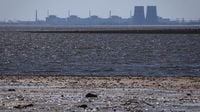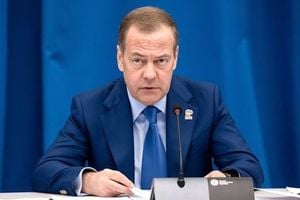The Zaporizhzhia nuclear power plant, Europe’s largest, has once again become the focus of international concern as the United Nations nuclear watchdog intensifies its push for a local ceasefire between Ukraine and Russia. The aim? To restore external power to the embattled facility, which has been running on diesel generators since September 23, 2025, after its last remaining power line was severed amid ongoing hostilities.
According to reporting by ABC and the Associated Press, the International Atomic Energy Agency (IAEA) has proposed a two-phase plan to address the urgent situation. The plan, shared by diplomats familiar with the negotiations, seeks to establish temporary ceasefire zones so that critical repairs can be carried out on the plant’s main and backup power lines. The IAEA’s Director General, Rafael Grossi, has been at the heart of these diplomatic efforts, engaging intensively with both Ukrainian and Russian officials in recent weeks.
The Zaporizhzhia plant, located in a region under Russian control since Moscow’s full-scale invasion in March 2022, is not currently producing electricity. However, it still requires a reliable source of power to cool its six shutdown reactors and spent nuclear fuel—an essential step to prevent a catastrophic nuclear incident. The plant’s reliance on diesel generators is a precarious situation; as the IAEA has warned, if these generators fail, the result could be a complete blackout, potentially leading to fuel melting and the release of radiation into the environment.
The IAEA’s proposal is straightforward in concept but fraught with political and logistical challenges. The first phase calls for a 1.5-kilometer-radius ceasefire zone around the Russian-controlled area where the main 750-kilovolt Dniprovska line needs repairs. The second phase would see a similar zone established in Ukrainian-controlled territory to fix the 330-kilovolt backup Ferosplavna-1 line. IAEA experts would be on-site to monitor the process, ensuring that repairs are conducted safely and transparently.
The repairs were initially scheduled for a seven-day window, from October 11 to October 17, 2025. Ukraine has provided the necessary guarantees for the safe passage of repair crews through its territory, demonstrating its willingness to facilitate the restoration of power. However, Russia did not provide similar guarantees in time for the work to begin as planned. A Russian diplomat, speaking to the Associated Press on condition of anonymity, suggested that preparations for the repairs are underway and could begin soon, but the lack of formal guarantees has delayed the process.
Director General Grossi has been deeply involved in shuttle diplomacy to break the deadlock. On September 25, 2025, he met with Russian President Vladimir Putin in Moscow, followed by talks with Rosatom Director General Alexei Likhachev on September 26. Just days later, on September 29, he conferred with Ukrainian Foreign Minister Andrii Sybiha at the Warsaw Security Forum. The IAEA has declined to comment on the precise timing of the repairs, stating only that Grossi is engaging “intensively with both sides” in an effort to “help prevent a nuclear accident.”
The urgency is palpable. The current blackout at Zaporizhzhia is the tenth time the plant has lost all external power since the war began, but it is by far the longest such outage. The 330-kilovolt backup line was lost in May, and the main line was disconnected on September 23. Throughout these incidents, Ukraine and Russia have repeatedly traded blame for shelling and sabotage near the plant, further complicating efforts to ensure its safety.
Ukrainian President Volodymyr Zelenskyy, in a video address on October 12, 2025, reiterated his country’s readiness to repair the power lines under its control. “Ukraine is again ready to repair power lines under its control as it has done dozens of times before,” Zelenskyy said, according to the Associated Press. However, he accused Russia of being uninterested in restoring safety at the plant, adding, “It must be pressured into doing so.”
The Zaporizhzhia facility’s strategic and symbolic importance cannot be overstated. Not only is it a critical piece of Ukraine’s energy infrastructure, but it also sits perilously close to the front lines of the ongoing conflict. Since Russian forces took control of the plant in March 2022, the site has become a flashpoint, with both sides accusing each other of endangering nuclear safety through military actions in the vicinity.
The IAEA’s role as a neutral arbiter has been crucial in this fraught environment. By proposing localized ceasefires and offering to oversee repairs, the agency hopes to carve out a temporary oasis of cooperation in an otherwise hostile landscape. The stakes are high: a failure to restore stable external power could have dire consequences, not just for Ukraine and Russia, but for the broader region. As the IAEA has repeatedly emphasized, the risk of a nuclear accident grows with each passing day that the plant operates on emergency power alone.
Despite the diplomatic impasse, there are glimmers of hope. Ukrainian officials have demonstrated a consistent willingness to facilitate repairs, and Russian representatives have indicated that preparations are ongoing. Still, the clock is ticking, and the international community watches with bated breath. The IAEA, for its part, continues to press both sides for the necessary guarantees, determined to avert disaster through dialogue and technical cooperation.
The situation at Zaporizhzhia is a stark reminder of the broader perils facing Ukraine’s civilian infrastructure amid war. Nuclear safety, once taken for granted in peacetime, has become a daily concern for those living near the plant and for policymakers around the world. The outcome of the current standoff will not only determine the fate of the Zaporizhzhia plant but may also set a precedent for how critical infrastructure is protected—or imperiled—in future conflicts.
For now, the world waits as diplomats, engineers, and nuclear experts work against the odds to restore a measure of stability to one of Europe’s most sensitive sites. The story of Zaporizhzhia is still unfolding, but one thing is clear: the risk of inaction is simply too great to ignore.





